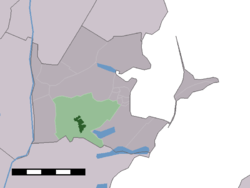Broek in Waterland
| Broek in Waterland | ||
|---|---|---|
| Town | ||
|
De Erven | ||
| ||
 | ||
 The town centre (darkgreen) and the statistical district (lightgreen) of Broek in Waterland in the municipality of Waterland. | ||
| Coordinates: 52°26′10″N 4°59′39″E / 52.43611°N 4.99417°ECoordinates: 52°26′10″N 4°59′39″E / 52.43611°N 4.99417°E | ||
| Country | Netherlands | |
| Province | Noord-Holland | |
| Municipality | Waterland | |
| Population | ||
| • Total | 2,300 | |
| Time zone | CET (UTC+1) | |
| • Summer (DST) | CEST (UTC+2) | |
Broek in Waterland is a town in the Dutch province of North Holland with about 2350 inhabitants. It is a part of the municipality of Waterland, and is situated about 8 km south of Purmerend and 8 km northeast of Amsterdam. In the 17th and 18th century, the town was a popular residence for merchants and seafarers from Amsterdam. Due to its monument status, much of its history has been preserved.
History
Broek in Waterland was a popular vacation village for sea captains in the 1600s.[1]
Many of the houses in the village date back to before 1850. Before 1940 there had been only limited housing development. This meant that many houses were divided to accommodate several families under the same roof.
In the past the town was famous for its cleanliness. Many 17th and 18th century travelbooks of foreign travellers mentioned the cleanliness and tidyness of the village.
The extreme cleanliness of Broek in Waterland led French visitors in the first half of the eighteenth century to dub this dairying village "le temple de la propreté hollandaise".[2]
The church of Broek in Waterland was built before 1400 and was dedicated to Saint Nicolas. On September 26, 1573 the church was razed to the ground by Spaniards during the Eighty Years' War. In 1628 the inhabitants of Broek in Waterland started to rebuild the church on the foundations of the old building. The pulpit was donated to the church in 1685 by a wealthy couple who were married there in 1641. It is made of ebony, rosewood and pallisander wood, which give it a dark colour and delicate texture. The church organ was built in 1832 by Wander Beekes. The church was extensively renovated in 1989. During this renovation, the original ceiling frescoes of cherubs and fruit garlands were rediscovered under old layers of paint.
Broek in Waterland was a separate municipality until 1991, when it was merged with Waterland.[3]
References
- ↑ DK Eyewitness Travel Guide: The Netherlands: The Netherlands. DK Publishing. 1 August 2011. p. 178. ISBN 978-0-7566-8476-1.
- ↑ van Bavel, Bas; Gelderblom, Oscar (2007-07-27). "Land of Milk and Butter. The Economic Origins of Cleanliness in the Dutch Golden Age" (pdf). Draft. www.lowcountries.nl. Retrieved 2009-05-07.
- ↑ Ad van der Meer and Onno Boonstra, "Repertorium van Nederlandse gemeenten", KNAW, 2006. "Archived copy". Archived from the original on 2007-02-20. Retrieved 2009-12-03.
External links
 Media related to Broek in Waterland at Wikimedia Commons
Media related to Broek in Waterland at Wikimedia Commons Broek in Waterland travel guide from Wikivoyage
Broek in Waterland travel guide from Wikivoyage- J. Kuyper, Gemeente Atlas van Nederland, 1865-1870, "Broek in Waterland". Map of the former municipality in 1868.
